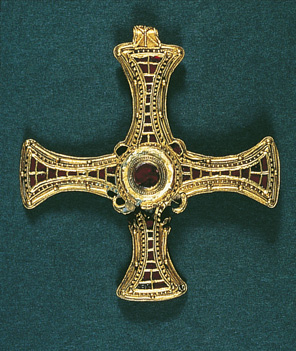
St Cuthbert's pectoral cross, one of the few items of value to have survived from the shrine, probably because the king's commissioners did not see it. It is made of gold and garnets.
© Durham Cathedral and Jarold Printing
(From the Rites of Durham, 1530s)
Opening the Shrine
His job was to look after the Holy Shrine of St Cuthbert. Whenever someone important wished to offer prayers or offerings at the shrine, and asked to see it, the Clerk of the Shrine, would immediately inform the Keeper. He would then fetch the keys of the shrine and hand them over to the Clerk to open it. It was for him to command and supervise the lifting of the cover from the Shrine, which was also done when the Te Deum was sung at Matins and the Magnificat at Evensong, and at High Mass.
The Presentation of Offerings
When the worshipper presented gold, silver, or jewels for the Shrine, they were immediately hung upon it. If the present were something like a unicorn’s horn or an elephant’s tooth it was hung outside the shrine in the Feretory.
Closing the Shrine
Afterwards, the Clerk would let down the Shrine cover, lock it at each corner and hand the keys back to the Keeper once more.

Narwhal tusks were thought to be the horns of unicorns and were very highly prized, because they were extremely rare and believed to have magical properties. Those given as gifts to the shrine of St Cuthbert would have been on permanent display.

